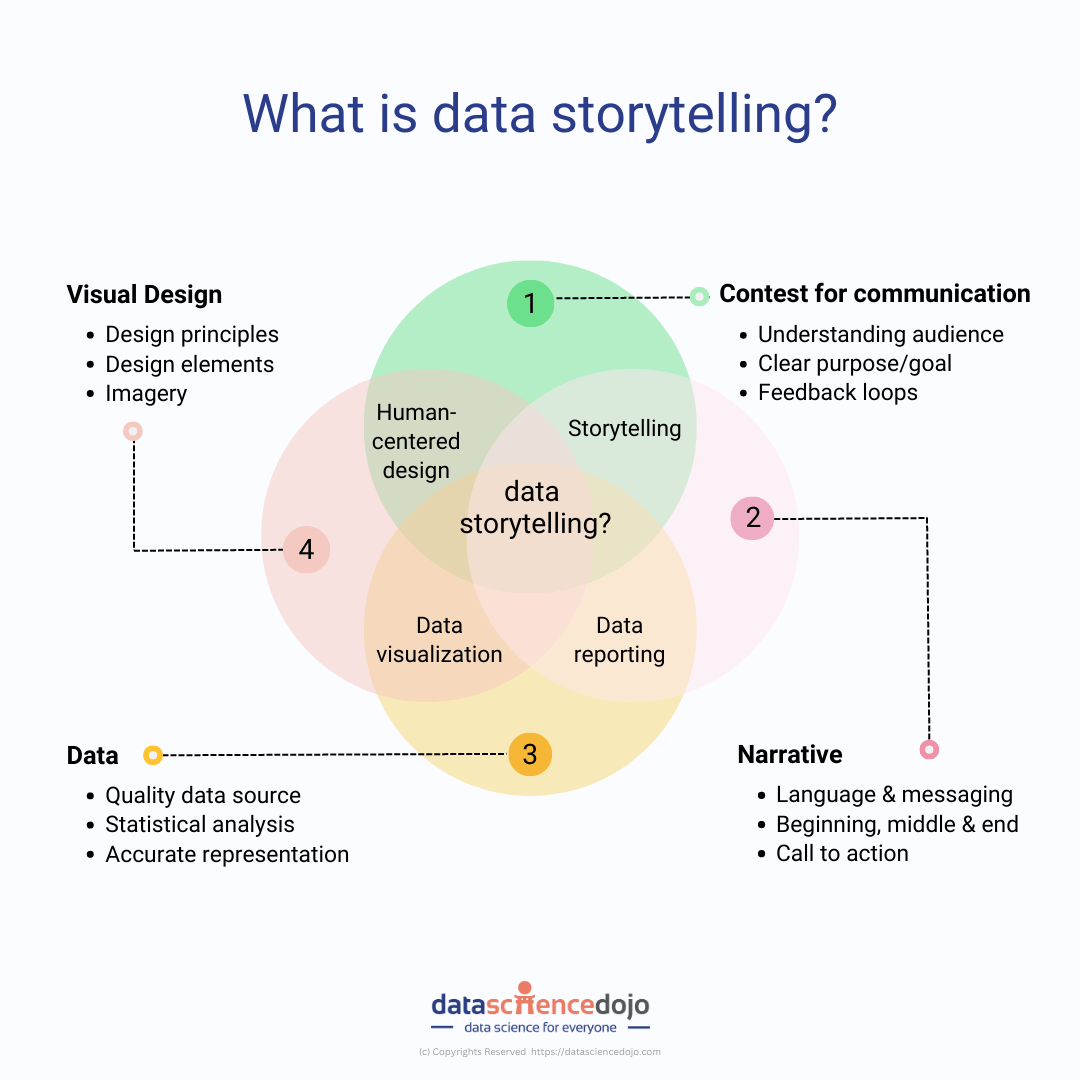Have you ever heard a story told with numbers? That’s the magic of data storytelling, and it’s taking the world by storm. If you’re ready to captivate your audience with compelling data narratives, you’ve come to the right place.

Everyone loves data—it’s the reason your organization is able to make informed decisions on a regular basis. With new tools and technologies becoming available every day, it’s easy for businesses to access the data they need rather than search for it. Unfortunately, this also means that increasingly people are seeing the ins and outs of presenting data in an understandable way.
The rise in social media has allowed people to share their experiences with a product or service without having to look them up first. As a result, businesses are being forced to present data in a more refined way than ever before if they want to retain customers, generate leads, and retain brand loyalty.
What is data storytelling?
Data storytelling is the process of using data to communicate the story behind the numbers—and it’s a process that’s becoming more and more relevant as more people learn how to use data to make decisions. In the simplest terms, data storytelling is the process of using numerical data to tell a story. A good data story allows a business to dive deeper into the numbers and delve into the context that led to those numbers.
For example, let’s say you’re running a health and wellness clinic. A patient walks into your clinic, and you diagnose that they have low energy, are stressed out, and have an overall feeling of being unwell. Based on this, you recommend a course of treatment that addresses the symptoms of stress and low energy. This data story could then be used to inform the next steps that you recommend for the patient.
Why is data storytelling important in three main fields: Finance, healthcare, and education?
Finance – With online banking and payment systems becoming more common, the demand for data storytelling is greater than ever. Data can be used to improve a customer journey, improve the way your organization interacts with customers, and provide personalized services. Healthcare – With medical information becoming increasingly complex, data storytelling is more important than ever. In education – With more and more schools turning to data to provide personalized education, data storytelling can help drive outcomes for students.
The importance of authenticity in data storytelling
Authenticity is key when it comes to data storytelling. The best way to understand the importance of authenticity is to think about two different data stories. Imagine that in one, you present the data in a way that is true to the numbers, but the context is lost in translation. In the other example, you present the data in a more simplified way that reflects the situation, but it also leaves out key details. This is the key difference between data storytelling that is authentic and data storytelling that is not.
As you can imagine, the data store that is not authentic will be much less impactful than the first example. It may help someone, but it likely won’t have the positive impact that the first example did. The key to authenticity is to be true to the facts, but also to be honest with your readers. You want to tell a story that reflects the data, but you also want to tell a story that is true to the context of the data.
Register for our conference ‘Future of Data and AI’ to learn from esteemed leaders and discover how to put data storytelling into action. Don’t miss out!
How to do data storytelling in action?
Start by gathering all the relevant data together. This could include figures from products, services, and your business as a whole; it could also include data about how your customers are currently using your product or service. Once you have your data together, you’ll want to begin to create a content outline.
This outline should be broken down into paragraphs and sentences that will help you tell your story more clearly. Invest time into creating an outline that is thorough but also easy for others to follow.
Next, you’ll want to begin to find visual representations of your data. This could be images, infographics, charts, or graphs. The visuals you choose should help you to tell your story more clearly.
Once you’ve finished your visual content, you’ll want to polish off your data stories. The last step in data storytelling is to write your stories and descriptions. This will give you an opportunity to add more detail to your visual content and polish off your message.
The need for strategizing before you start
While the process of data storytelling is fairly straightforward, the best way to begin is by strategizing. This is a key step because it will help you to create a content outline that is thorough, complete, and engaging. You’ll also want to strategize by thinking about who you are writing your stories for. This could be a specific section of your audience, or it could be a wider audience. Once you’ve identified your audience, you’ll want to think about what you want to achieve.
This will help you to create a content outline that is targeted and specific. Next, you’ll want to think about what your content outline will look like. This will help you to create a content outline that is detailed and engaging. You’ll also want to consider what your content outline will include. This will help you to ensure that your content outline is complete, and that it includes everything you want to include.
Planning your content outline
There are a few key things that you’ll want to include in your content outline. These include audience pain points, a detailed overview of your content, and your strategy. With your strategy, you’ll want to think about how you plan to present your data. This will help you to create a content outline that is focused, and it will also help you to make sure that you stay on track.
Watch this video to know what your data tells you
Researching your audience and understanding their pain points
With the planning complete, you’ll want to start to research your audience. This will help you to create a content outline that is more focused and will also help you to understand your audience’s pain points. With pain points in mind, you’ll want to create a content outline that is more detailed, engaging, and honest. You’ll also want to make sure that you’re including everything that you want to include in your content outline.
Next, you’ll want to start to research your pain points. This will help you to create a content outline that is more detailed and engaging.
Before you begin to create your content outline, you’ll want to start to think about your audience. This will help you to make connections and to start creating your content outline. With your audience in mind, you’ll want to think about how to present your information. This will help you to create a content outline that is more detailed, engaging, and focused.
The final step in creating your content outline is to decide where you’re going to publish your data stories. If you’re going to publish your content on a website, you should think about the layout that you want to use. You’ll want to think about the amount of text and the number of images you want to include.
The need for strategizing before you start
Just as a good story always has a beginning, a middle, and an end, so does a good data story. The best way to start is by gathering all the relevant data together and creating a content outline. Once you’ve done this, you can begin to strategize and make your content more engaging, and you’ll want to make sure that you stay on track.
Mastering your message: How to create a winning content outline
The first thing that you’ll want to think about when it comes to planning your content outline is your strategy. This will help you to make sure that you stay on track with your content outline. Next, you’ll want to think about your audience’s pain points. This will help you to make sure that you stay focused on the most important aspects of your content.
Researching your audience and understanding their pain points
The final thing that you’ll want to do before you begin to create your content outline is to research your audience. This will help you to make sure that you stay focused on the most important aspects of your content. With pain points in mind, you’ll want to make sure that you stay focused on the most important aspects of your content.
Next, you’ll want to start to research your audience. This will help you to make sure that you stay focused on the most important aspects of your content.
By approaching data storytelling in this way, you should be able to create engaging, detailed, and targeted content.
The bottom line: What we’ve learned
In conclusion, data storytelling is a powerful tool that allows businesses to communicate complex data in a simple, engaging, and impactful way. It can help to inform and persuade customers, generate leads, and drive outcomes for students. Authenticity is a key component of effective data storytelling, and it’s important to be true to the facts while also being honest with your readers.
With careful planning and a thorough content outline, anyone can create powerful and effective data stories that engage and inspire their audience. As data continues to play an increasingly important role in decision-making across a wide range of industries, mastering the art of data storytelling is an essential skill for businesses and individuals alike.


